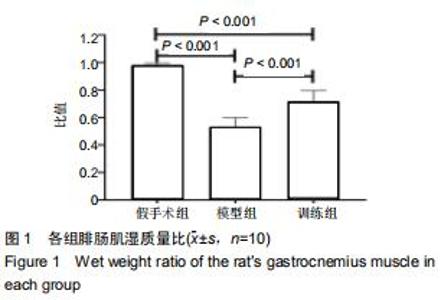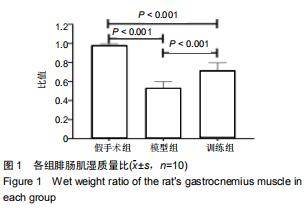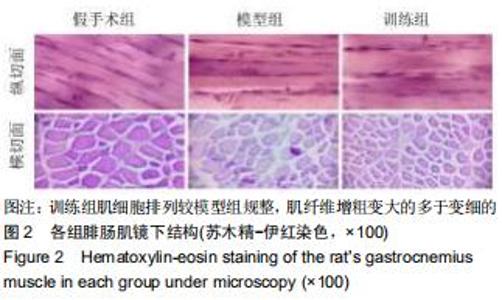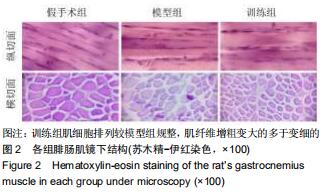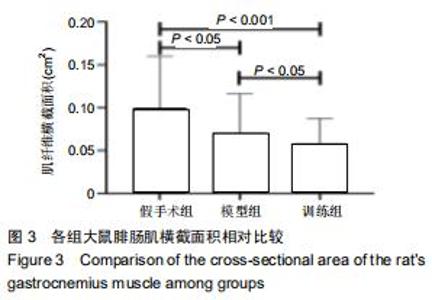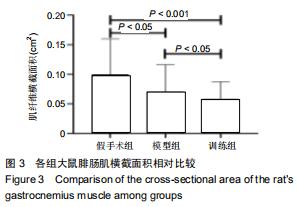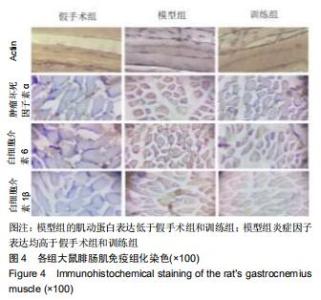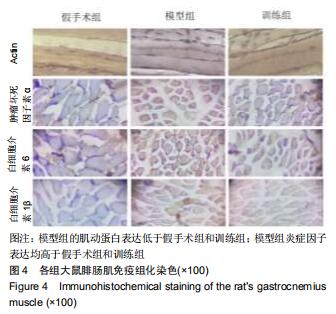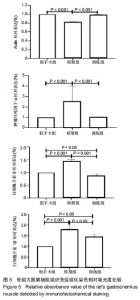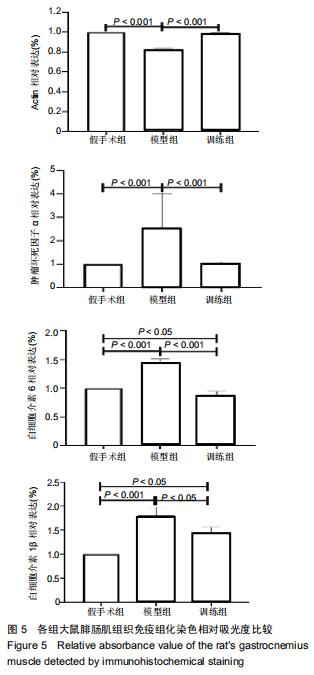Chinese Journal of Tissue Engineering Research ›› 2020, Vol. 24 ›› Issue (32): 5138-5144.doi: 10.3969/j.issn.2095-4344.2862
Previous Articles Next Articles
Passive training improves the recovery of skeletal muscle structure and function in rats with denervated muscle atrophy
Wang Shiyang1, 2, Sun Huizhe1, Yan Nan1, Wang Xiaojie1, Zhang Hongxin3, Guan Lili1, Li Fenjie1, Wang Zhengdong1
- 1School of Basic Medicine, Shenyang Medical College, Shenyang 110034, Liaoning Province, China; 2Shenyang Red Cross Hospital, Shenyang 110034, Liaoning Province, China; 3Second Affiliated Hospital of Shenyang Medical Collee, Shenyang 110034, Liaoning Province, China
-
Received:2020-02-25Revised:2020-03-03Accepted:2020-03-30Online:2020-11-18Published:2020-09-25 -
Contact:Wang Zhengdong, MD, Associate professor, School of Basic Medicine, Shenyang Medical College, Shenyang 110034, Liaoning Province, China -
About author:Wang Shiyang, Physician, School of Basic Medicine, Shenyang Medical College, Shenyang 110034, Liaoning Province, China; Shenyang Red Cross Hospital, Shenyang 110034, Liaoning Province, China -
Supported by:the Natural Science Foundation of Liaoning Province in 2017, No. 20170540886; Student Research Project of Shenyang Medical College, No. 20141032
CLC Number:
Cite this article
Wang Shiyang, Sun Huizhe, Yan Nan, Wang Xiaojie, Zhang Hongxin, Guan Lili, Li Fenjie, Wang Zhengdong. Passive training improves the recovery of skeletal muscle structure and function in rats with denervated muscle atrophy[J]. Chinese Journal of Tissue Engineering Research, 2020, 24(32): 5138-5144.
share this article
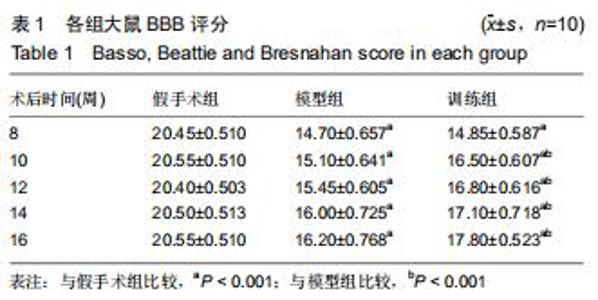
2.2 各组大鼠后肢运动功能大鼠脊髓损伤评分 实验成功造模后大鼠表现为左下肢立即瘫痪,BBB评分为0分。术后8周时以及康复训练后每隔2周,采用BBB评分评价各组大鼠左后肢运动功能,各组大鼠后肢关节活动次数、运动负荷、伸展范围以及前后肢的协调度均有不同程度恢复,模型组和训练组大鼠BBB评分均有不同程度提高。4周时训练组和模型组两组BBB评分间差异无显著性意义(P > 0.05),但这两组BBB评分与假手术组相比,差异均有显著性意义(P < 0.001),之后各检测时间点训练组BBB评分较模型组明显改善提高(P < 0.001),两组BBB评分与假手术组相比差异有显著性意义(P < 0.001),见表1。 "
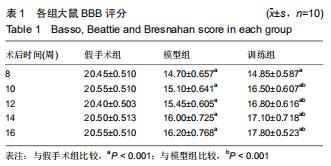
|
[1] BOSKOVSKI MT, THOMSON JG. Carpal tunnel syndrome, syndrome of partial thenar atrophy, and W. Russell Brain: a historical perspective. J Hand Surg Am. 2014;39(9): 1822-1829 e1.
[2] JUNQUERA L, GALLEGO L.Images in clinical medicine. Denervation atrophy of the tongue after hypoglossal-nerve injury. N Engl J Med. 2012;367(2):156.
[3] NADERI J, BERNREUTHER C, GRABINSKI N. Plasminogen activator inhibitor type 1 up-regulation is associated with skeletal muscle atrophy and associated fibrosis. Am J Pathol. 2009;175(2):763-771.
[4] AGUERA E, CASTILLA S, LUQUE E.Denervated muscle extract promotes recovery of muscle atrophy through activation of satellite cells. An experimental study. J Sport Health Sci. 2019;8(1):23-31.
[5] GIGER JM, BODELL PW, ZENG M. Rapid muscle atrophy response to unloading: pretranslational processes involving MHC and actin. J Appl Physiol (1985). 2009;107(4): 1204-1212.
[6] WADA E, TANIHATA J, IWAMURA A.Treatment with the anti-IL-6 receptor antibody attenuates muscular dystrophy via promoting skeletal muscle regeneration in dystrophin-/utrophin-deficient mice. Skelet Muscle. 2017; 7(1):23.
[7] WEI J, LIANG BS. PPM1B and P-IKKbeta expression levels correlated inversely with rat gastrocnemius atrophy after denervation. Braz J Med Biol Res.2012;45(8): 711-715.
[8] HILLEN BK, YAMAGUCHI GT, ABBAS JJ, et al. Joint-specific changes in locomotor complexity in the absence of muscle atrophy following incomplete spinal cord injury. J Neuroeng Rehabil. 2013;10:97.
[9] MA W, ZHANG R, HUANG Z, et al. PQQ ameliorates skeletal muscle atrophy, mitophagy and fiber type transition induced by denervation via inhibition of the inflammatory signaling pathways. Ann Transl Med.2019;7(18): 440.
[10] JIANG GL, GU YD, ZHANG LY. Randomized, double-blind, and placebo-controlled trial of clenbuterol in denervated muscle atrophy. ISRN Pharm. 2011;2011:981254.
[11] HORII N, UCHIDA M, HASEGAWA N. Resistance training prevents muscle fibrosis and atrophy via down-regulation of C1q-induced Wnt signaling in senescent mice. FASEB J. 2018;32(7):3547-3559.
[12] HUANG Z, FANG Q, MA W. Skeletal Muscle Atrophy Was Alleviated by Salidroside Through Suppressing Oxidative Stress and Inflammation During Denervation. Front Pharmacol. 2019;10:997.
[13] WENG J, WANG YH, LI M, et al. GSK3β inhibitor promotes myelination and mitigates muscle atrophy after peripheral nerve injury. Neural Regen Res. 2018;13(2):324-330.
[14] 李枚原,薛成斌,韦中亚.大鼠失神经支配后比目鱼肌和趾长伸肌超微结构变化的实验研究[J].交通医学,2011,25(2):107-109.
[15] 董进,柯棠山,刘坤祥.大鼠失神经不同时相的骨骼肌形态和MyoD表达变化[J].现代医药卫生. 2015,36(8):1124-6+30.
[16] SZCZEPANOWSKA J, BOROVIKOV YS, JAKUBIEC-PUKA A. Effects of denervation and muscle inactivity on the organization of F-actin. Muscle Nerve. 1998;21(3):309-317.
[17] RILEY DA, BAIN JL, THOMPSON JL. Disproportionate loss of thin filaments in human soleus muscle after 17-day bed rest. Muscle Nerve. 1998;21(10):1280-1289.
[18] TAMAKI H, YOTANI K, OGITA F. Electrical Stimulation of Denervated Rat Skeletal Muscle Ameliorates Bone Fragility and Muscle Loss in Early-Stage Disuse Musculoskeletal Atrophy. Calcif Tissue Int. 2017;100(4):420-430.
[19] THEILEN NT, JEREMIC N, WEBER GJ. Exercise preconditioning diminishes skeletal muscle atrophy after hindlimb suspension in mice. J Appl Physiol (1985). 2018; 125(4):999-1010.
[20] NAKAGAWA K, TAMAKI H, HAYAO K. Electrical Stimulation of Denervated Rat Skeletal Muscle Retards Capillary and Muscle Loss in Early Stages of Disuse Atrophy. Biomed Res Int. 2017;2017:5695217.
[21] FINNI T, HODGSON JA, LAI AM. Mapping of movement in the isometrically contracting human soleus muscle reveals details of its structural and functional complexity. J Appl Physiol (1985). 2003;95(5):2128-2133.
[22] HADDAD F, ZALDIVAR F, COOPER DM. IL-6-induced skeletal muscle atrophy. J Appl Physiol (1985). 2005;98(3): 911-917.
[23] MA W, ZHANG R, HUANG Z. PQQ ameliorates skeletal muscle atrophy, mitophagy and fiber type transition induced by denervation via inhibition of the inflammatory signaling pathways. Ann Transl Med. 2019;7(18):440.
[24] WU C, TANG L, NI X. Salidroside Attenuates Denervation-Induced Skeletal Muscle Atrophy Through Negative Regulation of Pro-inflammatory Cytokine. Front Physiol. 2019;10:665.
[25] AL-NASSAN S, FUJITA N, KONDO H. Chronic Exercise Training Down-Regulates TNF-alpha and Atrogin-1/MAFbx in Mouse Gastrocnemius Muscle Atrophy Induced by Hindlimb Unloading. Acta Histochem Cytochem. 2012;45(6):343-349.
[26] HE Q, QIU J, DAI M. MicroRNA-351 inhibits denervation-induced muscle atrophy by targeting TRAF6. Exp Ther Med. 2016;12(6):4029-4034.
[27] ZHOU L, HUANG Y, XIE H. Buyang Huanwu Tang improves denervation-dependent muscle atrophy by increasing ANGPTL4, and increases NF-kappaB and MURF1 levels. Mol Med Rep. 2018;17(3):3674-3680.
[28] OBERBACH A, LEHMANN S, KIRSCH K. Long-term exercise training decreases interleukin-6 (IL-6) serum levels in subjects with impaired glucose tolerance: effect of the -174G/C variant in IL-6 gene. Eur J Endocrinol. 2008;159(2): 129-136. [29] MAMMEN AL, SARTORELLI V. IL-6 Blockade as a Therapeutic Approach for Duchenne Muscular Dystrophy. EBioMedicine. 2015;2(4):274-275.
[30] MIYAGI MY, SEELAENDER M, CASTOLDI A. Long-term aerobic exercise protects against cisplatin-induced nephrotoxicity by modulating the expression of IL-6 and HO-1. PLoS One. 2014;9(10):e108543.
[31] MADARO L, PASSAFARO M, SALA D. Denervation-activated STAT3-IL-6 signalling in fibro-adipogenic progenitors promotes myofibres atrophy and fibrosis. Nat Cell Biol. 2018; 20(8):917-927.
[32] SISHI BJ, ENGELBRECHT AM. Tumor necrosis factor alpha (TNF-alpha) inactivates the PI3-kinase/PKB pathway and induces atrophy and apoptosis in L6 myotubes. Cytokine. 2011;54(2):173-184.
[33] KERN H, HOFER C, LOEFLER S. Atrophy, ultra-structural disorders, severe atrophy and degeneration of denervated human muscle in SCI and Aging. Implications for their recovery by Functional Electrical Stimulation, updated 2017. Neurol Res. 2017;39(7):660-666.
[34] IMASAKA K I, TOMITA Y, NISHIJIMA T, et al. Pectoral Muscle Atrophy After Axillary Artery Cannulation for Aortic Arch Surgery . Semin Thorac Cardiovasc Surg.2019; 31(3): 414-21.
[35] HAMANO N, YAMAMOTO A, SHITARA H, et al. Does successful rotator cuff repair improve muscle atrophy and fatty infiltration of the rotator cuff? A retrospective magnetic resonance imaging study performed shortly after surgery as a reference. J Shoulder Elbow Surg.2017;26(6): 967-974.
[36] RUVEN C, LI W, LI H, et al. Transplantation of Embryonic Spinal Cord Derived Cells Helps to Prevent Muscle Atrophy after Peripheral Nerve Injury. Int J Mol Sci.2017;18(3):
[37] GU S, SHEN Y, XU W, et al. Application of fetal neural stem cells transplantation in delaying denervated muscle atrophy in rats with peripheral nerve injury. Microsurgery.2010;30(4): 266-274.
[38] ZHANG PX, HAN N, KOU YH, et al. Tissue engineering for the repair of peripheral nerve injury. Neural Regen Res. 2019; 14(1):51-58.
[39] MOIMAS S, NOVATI F, RONCHI G, et al. Effect of vascular endothelial growth factor gene therapy on post-traumatic peripheral nerve regeneration and denervation-related muscle atrophy. Gene Ther.2013; 20(10): 1014-1021.
[40] SCHAKMAN O, THISSEN J P. Gene therapy with anabolic growth factors to prevent muscle atrophy. Curr Opin Clin Nutr Metab Care.2006; 9(3): 207-13.
[41] ITOH Y, MURAKAMI T, MORI T, et al. Training at non-damaging intensities facilitates recovery from muscle atrophy. Muscle Nerve.2017; 55(2): 243-253.
[42] PANISSET M G, GALEA M P, EL-ANSARY D. Does early exercise attenuate muscle atrophy or bone loss after spinal cord injury?. Spinal Cord.2016;54(2): 84-92.
[43] RABELO M, DE MOURA JUCA R V B, LIMA L A O, et al. Overview of FES-Assisted Cycling Approaches and Their Benefits on Functional Rehabilitation and Muscle Atrophy. Adv Exp Med Biol.2018;1088:561-583. |
| [1] | Zhang Yu, Tian Shaoqi, Zeng Guobo, Hu Chuan. Risk factors for myocardial infarction following primary total joint arthroplasty [J]. Chinese Journal of Tissue Engineering Research, 2021, 25(9): 1340-1345. |
| [2] | Xiao Guoqing, Liu Xuanze, Yan Yuhao, Zhong Xihong. Influencing factors of knee flexion limitation after total knee arthroplasty with posterior stabilized prostheses [J]. Chinese Journal of Tissue Engineering Research, 2021, 25(9): 1362-1367. |
| [3] | Zhang Chong, Liu Zhiang, Yao Shuaihui, Gao Junsheng, Jiang Yan, Zhang Lu. Safety and effectiveness of topical application of tranexamic acid to reduce drainage of elderly femoral neck fractures after total hip arthroplasty [J]. Chinese Journal of Tissue Engineering Research, 2021, 25(9): 1381-1386. |
| [4] | Wang Haiying, Lü Bing, Li Hui, Wang Shunyi. Posterior lumbar interbody fusion for degenerative lumbar spondylolisthesis: prediction of functional prognosis of patients based on spinopelvic parameters [J]. Chinese Journal of Tissue Engineering Research, 2021, 25(9): 1393-1397. |
| [5] | Liang Yan, Zhao Yongfei, Xu Shuai, Zhu Zhenqi, Wang Kaifeng, Liu Haiying, Mao Keya. Imaging evaluation of short-segment fixation and fusion for degenerative lumbar scoliosis assisted by highly selective nerve root block [J]. Chinese Journal of Tissue Engineering Research, 2021, 25(9): 1423-1427. |
| [6] | Zhang Chao, Lü Xin. Heterotopic ossification after acetabular fracture fixation: risk factors, prevention and treatment progress [J]. Chinese Journal of Tissue Engineering Research, 2021, 25(9): 1434-1439. |
| [7] | Chen Jinping, Li Kui, Chen Qian, Guo Haoran, Zhang Yingbo, Wei Peng. Meta-analysis of the efficacy and safety of tranexamic acid in open spinal surgery [J]. Chinese Journal of Tissue Engineering Research, 2021, 25(9): 1458-1464. |
| [8] | Shu Wenbo, Chen Mengchi, Li Hua, Huang Liqian, Huang Binbin, Zhang Wenhai, Wu Yachen, Wang Zefeng, Li Qiaoli, Liu Peng. Correlation between body fat distribution and characteristics of daily physical activity in college students [J]. Chinese Journal of Tissue Engineering Research, 2021, 25(8): 1277-1283. |
| [9] | Gu Xia, Zhao Min, Wang Pingyi, Li Yimei, Li Wenhua. Relationship between hypoxia inducible factor 1 alpha and hypoxia signaling pathway [J]. Chinese Journal of Tissue Engineering Research, 2021, 25(8): 1284-1289. |
| [10] | Ji Zhixiang, Lan Changgong. Polymorphism of urate transporter in gout and its correlation with gout treatment [J]. Chinese Journal of Tissue Engineering Research, 2021, 25(8): 1290-1298. |
| [11] | Wu Xun, Meng Juanhong, Zhang Jianyun, Wang Liang. Concentrated growth factors in the repair of a full-thickness condylar cartilage defect in a rabbit [J]. Chinese Journal of Tissue Engineering Research, 2021, 25(8): 1166-1171. |
| [12] | Shen Jinbo, Zhang Lin. Micro-injury of the Achilles tendon caused by acute exhaustive exercise in rats: ultrastructural changes and mechanism [J]. Chinese Journal of Tissue Engineering Research, 2021, 25(8): 1190-1195. |
| [13] | Li Jing, Xie Jianshan, Cui Huilin, Cao Ximei, Yang Yanping, Li Hairong. Expression and localization of diacylglycerol kinase zeta and protein kinase C beta II in mouse back skin with different coat colors [J]. Chinese Journal of Tissue Engineering Research, 2021, 25(8): 1196-1200. |
| [14] | Zeng Zhen, Hu Jingwei, Li Xuan, Tang Linmei, Huang Zhiqiang, Li Mingxing. Quantitative analysis of renal blood flow perfusion using contrast-enhanced ultrasound in rats with hemorrhagic shock during resuscitation [J]. Chinese Journal of Tissue Engineering Research, 2021, 25(8): 1201-1206. |
| [15] | Tang Hui, Yao Zhihao, Luo Daowen, Peng Shuanglin, Yang Shuanglin, Wang Lang, Xiao Jingang. High fat and high sugar diet combined with streptozotocin to establish a rat model of type 2 diabetic osteoporosis [J]. Chinese Journal of Tissue Engineering Research, 2021, 25(8): 1207-1211. |
| Viewed | ||||||
|
Full text |
|
|||||
|
Abstract |
|
|||||
